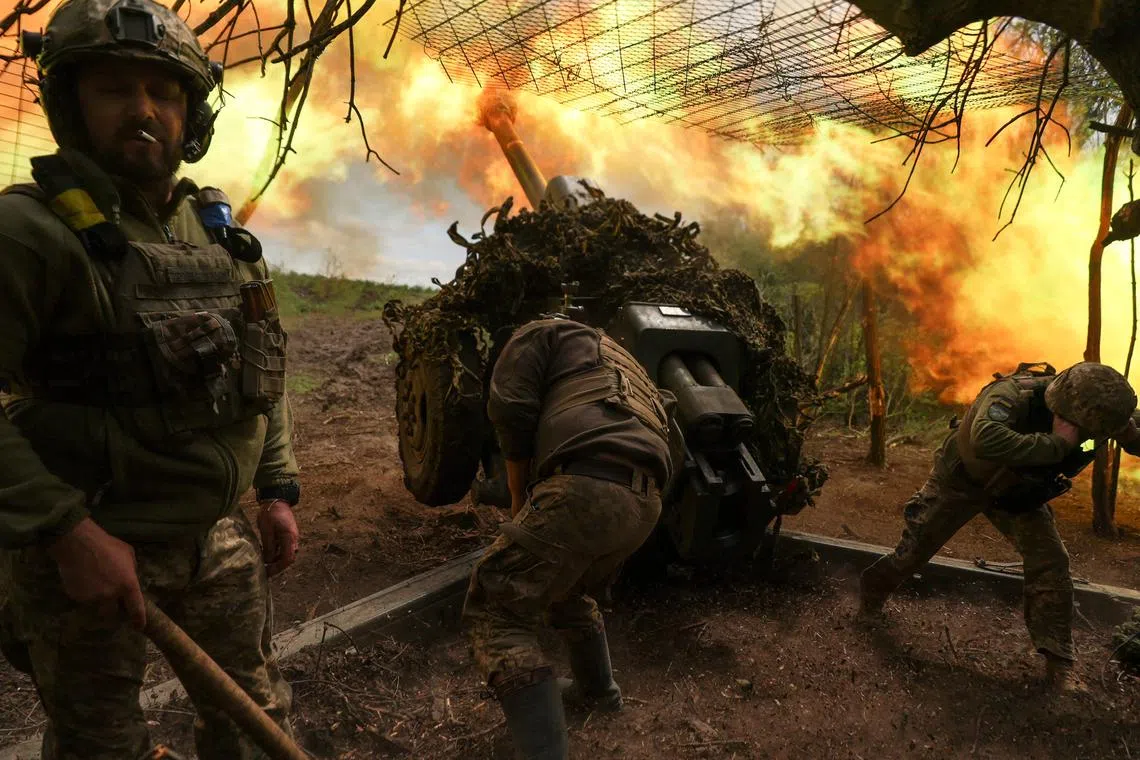Russia takes its Ukraine information war into video games
Sign up now: Get ST's newsletters delivered to your inbox

In Minecraft, Russian players re-enacted the battle for Soledar, a city in Ukraine that Russian forces captured in January.
PHOTO: REUTERS
Follow topic:
SAN FRANCISCO – Russian propaganda is spreading into the world’s video games.
In Minecraft, the immersive game owned by Microsoft, Russian players re-enacted the battle for Soledar, a city in Ukraine that Russian forces captured in January,
A channel on the Russian version of World of Tanks, a multiplayer warfare game, commemorated the 78th anniversary of the defeat of Nazi Germany in May with a re-creation of the Soviet Union’s parade of tanks in Moscow in 1945.
On Roblox, the popular gaming platform, a user created an array of Interior Ministry forces in June to celebrate the national holiday, Russia Day.
These games and adjacent discussion sites such as Discord and Steam are becoming online platforms for Russian agitprop, circulating to new, mostly younger audiences a torrent of propaganda that the Kremlin has used to try to justify the war in Ukraine.
In this virtual world, players have adopted the letter Z, a symbol of the Russian troops who invaded in 2022; embraced legally specious Russian territorial claims in Crimea and other places; and echoed Russian President Vladimir Putin’s efforts to denigrate Ukrainians as Nazis and blame the West for the conflict.
“Glory to Russia,” declared a video tutorial on how to construct a flagpole with a Russian flag on Minecraft. It showed a Russian flag over a cityscape labelled Luhansk, one of the Ukrainian provinces that Russia has illegally annexed.
“The gaming world is really a platform that can impact public opinion, to reach an audience, especially young populations,” said Ms Tanya Bekker, a researcher at ActiveFence, a cyber security company that identified several examples of Russian propaganda on Minecraft for The New York Times.
Microsoft president Brad Smith disclosed in April that the company’s security teams had identified recent Russian efforts “basically to penetrate some of these gaming communities”, citing examples in Minecraft and in Discord discussion groups.
He said Microsoft had advised governments, which he did not name, about them, but he played down their significance.
“In truth, it’s not the number one thing we should worry about,” Mr Smith said at an economic conference in Washington organised by news website Semafor.
“They’re going to publish information somewhere. You know, it just happens to be a good place for them to get the information into circulation.”
The head of Microsoft’s threat analysis team, Mr Clint Watts, told researchers at New York University’s Stern School of Business that the Russian paramilitary force known as the Wagner Group promoted “malign narratives” on Discord and Steam to support the Kremlin’s views. It may have also sought to encourage enlistments when Russian combat casualties were taking an enormous toll.
“The propaganda mainly seeks to make Wagner and the Russian military look cool and menacing,” Mr Watts told the researchers, who were examining extremism in video games.
Microsoft declined to elaborate on its executives’ comments or to respond to questions about the Russian examples, except to say in a statement that the company reviews content that violates its community standards.
Although some of the material reflects the views of ordinary Russians, other examples suggested government involvement.
The Kremlin’s reach into video games shows how tenaciously Mr Putin’s government has sought to bolster its political goals by using Western social media and consumer products despite diplomatic and economic isolation.
In the wake of Russia’s invasion of Ukraine in February 2022, Microsoft announced that it would suspend new sales of products and services to Russia to comply with sanctions imposed by the United States and Europe, but Russians have continued to find ways to use its games and sites such as Discord and Steam to reach broader audiences.
Many of the examples are in Russian, suggesting that the intended audience is at home or among Russian speakers in neighbouring countries, including Ukraine.
“Russian propaganda is trying new things to promote its regime,” said Mr Artem Starosiek, the head of Molfar a Ukrainian consultancy that analyses online threats.
Molfar’s researchers identified more than a dozen instances of pro-Kremlin propaganda in Minecraft, Roblox, the Russian versions of World of Tanks and World of Warships, Fly Corp, Armoured Warfare and War Thunder.
Almost all extolled the Soviet victory over Nazi Germany, a theme Mr Putin and his advisers have used to build support for today’s war. Some of it had explicit links to political parties or government agencies.
It is not clear what steps, if any, Microsoft or other companies have taken to block Russian efforts. Wargaming Group, the Cyprus-based creator of World of Tanks, World of Warships and other games, spun off its Russian and Belarusian business in 2022 to Lesta Studio, a subsidiary in St Petersburg.
“Wargaming is vehement in the support of the people of Ukraine, our studio in Kyiv and our employees there,” Mr Alex Brewer-Disarufino, a spokesman for Wargaming in North America, said in an e-mail.
Mr Jacob Davey, the head of research of far-right and hate movements at the Institute for Strategic Dialogue in London, said Minecraft and other games could be useful tools for those looking to influence vulnerable young people, especially if those people had already sorted themselves into private groups where they were eager to discuss fringe ideologies.
“We know that hostile actors who are seeking to shape minds and influence people are opportunistic,” said Mr Davey, who has studied the gamification of extremist content online.
“They go where they think they might find a receptive audience, and they adopt a wide range of tech platforms to push their messaging out.” NYTIMES

